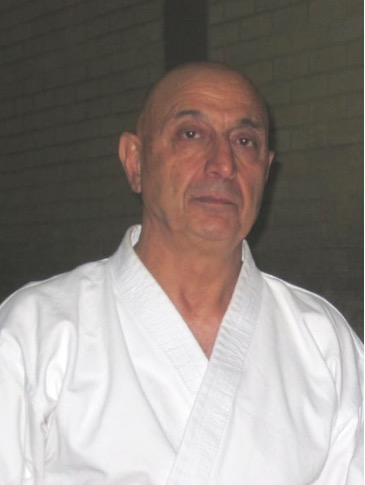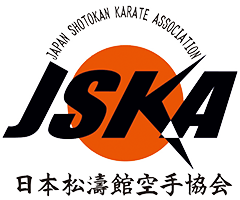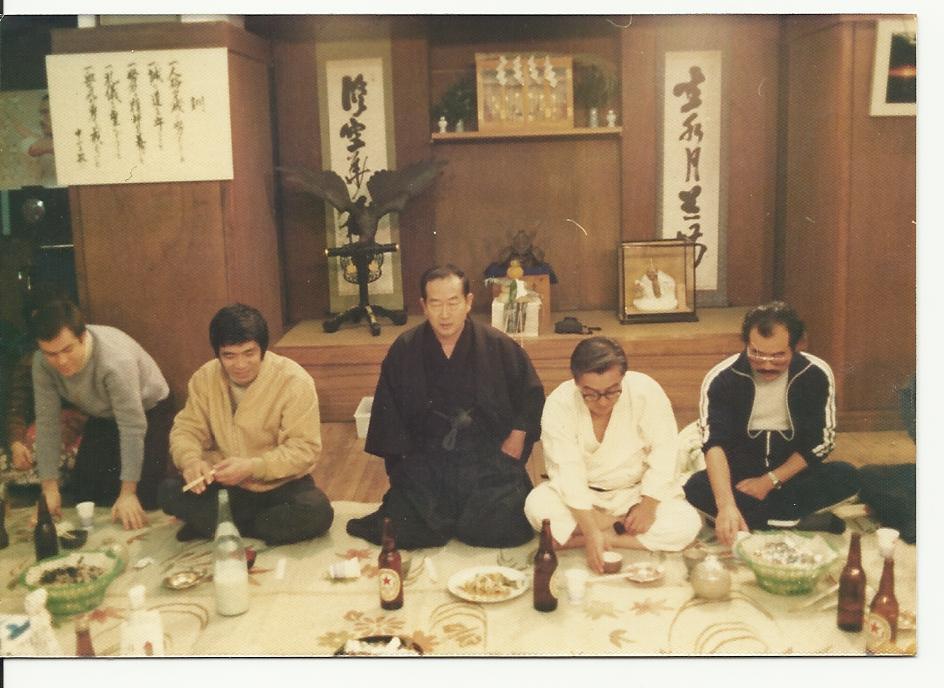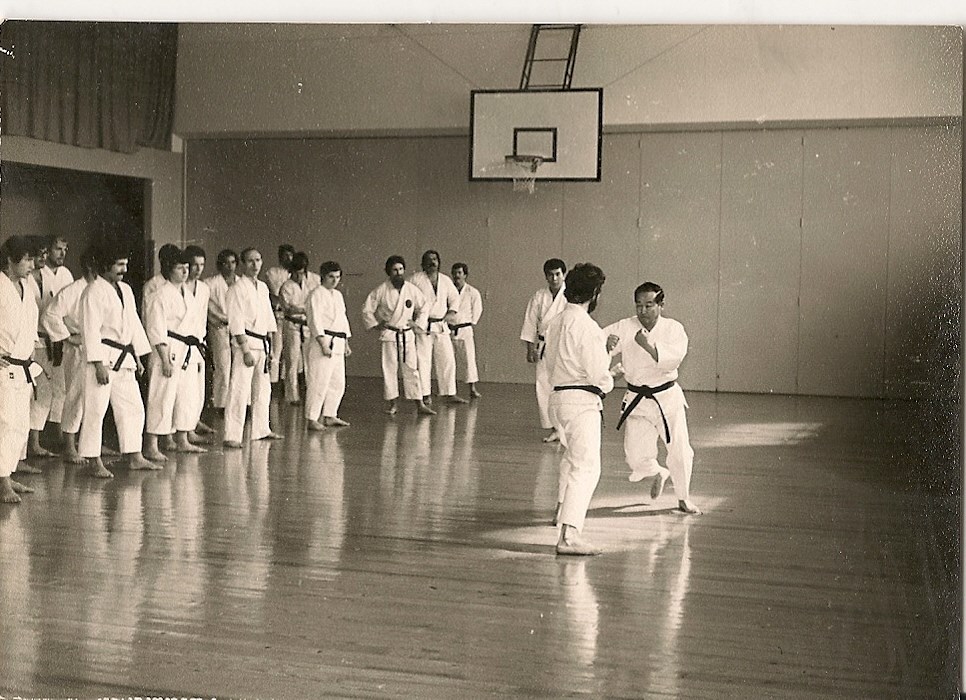
Welcome message from Jamsheed sensei
I am proudly introducing our new representatives in the continent of America to the JSKA family Sensei Ali Najafi (Vancouver) Sensei Babak Soutodeh (Toronto) Sensei Samir Baccouche ( Quebec) Sensei …

It is always with great pleasure that I relive my experiences at Master Nakayama’s Dojo Hoitsugan.
What I write today is just a summary of my experience as a Karate practitioner, my relationship with Karate Shotokan JKA and with Master Nakayama at Dojo Hoitsugan.
Allow me, before speaking about Hoitsugan, to pay tribute and deep thanks to the most extraordinary man I have met in Karate in my entire life.
It was a huge bliss and privilege to have Master Nakayama as a teacher during the years I lived at Hoitsugan.
There are really special men who, without imposition, become part of our lives forever.
They forgive our offenses, understand our mistakes, teach us with rigor and generosity, sharing their knowledge and experiences with affection.
They instill part of their being in our hearts, changing our personality in such a way that we are never the same again.
Master Nakayama was one of those men… my only master… such an honor he bestowed on me.
His life and way of being in Karate should serve as an inspiration and model for all karatekas.
Although his body will never be with us again, his teachings will always be present in Hoitsugan of Portugal, just as it was received in Hoitsugan of Japan.

I now have to go a little bit back in time to situate the moment when I decided to go to Japan.
Even though I started practicing Karate in 1966, I only joined the JKA in 1969, during a European Championship in London at the Royal Albert Hall under the aegis of sensei Enoeda.
Since then, Portugal started to organize several seminars with different JKA instructors such as – Kanazawa, Enoeda, Miyazaki, Tomita, Kato.
And it was at the end of a seminar with Kanazawa sensei, in February 1972, when I took my first black belt exam… I failed!
At dinner, I asked sensei why. So he said – Karate in Portugal is very primitive, you need a good instructor.
He was right and so I kept asking where we could find a good instructor. And his answer was – in Japan. And this was the exact moment of my decision to leave for Japan.
The next day, when I took sensei to the airport back to Japan, I told him that I had already started packing. He, smiling, exclaimed – ah so ka?
At the check-in entrance, he gave me his business card saying – when you arrive in japan, contact me and I will help you.
A few days later I started the odyssey of my trip to the country of the Rising Sun. It was an odyssey that lasted for three months, I lived in Brussels, between the home and the Dojo of sensei Miyazaki, also a great sensei and a man with a huge heart… I will never forget him!
But, because today the goal is the Hoitsugan Dojo, I won’t elaborate on descriptions related to my experience with sensei Miyazaki.
Leaving Brussels, flying to Tokyo, I faced the great challenge of overcoming the barrier of emigration at Haneda airport.
For those who don’t know, the emigration policy in Japan was, and I think it still is, extremely strict in the entry of foreigners. As a matter of fact, sensei Miyazaki had already warned me about the difficulties I would encounter… only I know the anxiety I felt from the airplane to the immigration desk.
I intended to apply for a tourist visa (three months). it would be very difficult to convince the emigration official to grant me a tourist visa, as I had just over 2000 yen in my pocket.
When the emigration agent asked me why I came to Japan I explained that I was going to train Karate in the Nihon Karate Kyokai (JKA) and at the same time I showed him Kanazawa sensei’s card. I understood then how important that card was.
He looked at me with a very serious face… at that moment I thought he was going to send me back to Portugal.
Suddenly, he showed a smile, with Kanazawa sensei’s card in is hand and said – Kanazawa sensei is my teacher. Ok you can go! And then stamped my passport with a visa for three months.
It was a moment of enormous relief and indescribable joy. I could hardly believe I was finally in Japan. it was my first victory in Japanese land.
In the taxi, I asked the driver to take me to the address registered on Kanazawa sensei’s card, without knowing that was the address of JKA, in Suidobashi.
Arriving in Suidobashi I came across an old building, partly occupied by a weightlifting gym and partly by the JKA-Honbu Dojo.
I went up some stairs to the 1st floor. In front was the office and on the left was the Dojo.

At the office I was attended by a gentleman. Later I came to know thatI he was a director of the JKA (sensei Takagi) to whom, after the usual greetings and introductions, I explained my purposes and once again showed Kanazawa sensei’s card.
While he made a few phone calls, I couldn’t resist the curiosity to peek under the brown cloth curtain that covered the view to the interior of the Dojo. I was intrigued by the kiais and the heavy stamp on the ground.
In a brief glance I saw two black belts training kihon-ippon kumite. I was impressed with such power and spirit of those two black belts. I had never seen anything like that. later I found out that those people were two of the most prominent JKA instructors – Kenji Yano and Takeshi Oishi.
The Dojo had a rectangular area, approximately 250m2 (25×10), considerably smaller compared to the Honbu that the JKA would acquire roughly a year later in Ebisu, 100m from the Hoitsugan Dojo.
For a brief moment I felt myself sinking into a dream. Everything I saw and felt seemed unreal. It was then that Takagi sensei woke me up.
He told me I had to wait a few minutes and in the meantime invited me to have coffee at a coffee shop next the Dojo. There we talked about various things. I remember him saying that Tokyo was the most expensive city in the world and, by the way, he wanted to know about which hotel I was staying. When I told him that a hotel was out of my financial means, I noticed his worried expression.
Back to the office, a gentleman was waiting for us to whom Takagi sensei gave some instructions, telling me to accompany him.
So I did. We went down the stairs and nearby took the subway. It was about a 15 minutes to Ebisu station.
During the trip I tried several times to establish a conversation with that gentleman without success so I gave up (this gentleman was – Akihito Isaka sensei).
We left the subway and after a walk of 5 minutes we reach the door of the mythical Dojo Hoitsugan.
We went down stairs to the basement and there was Hoitsugan Dojo.
I was sympathetically received by a Japanese lady (Jibiki san), who asked me to wait. She made a phone call probably to Nakayama Sensei because in a few minutes the Grand Master arrived.
It was an indescribable moment. There are no words for express the joy I felt.
Nakayama Sensei greeting me… extending his hand… showing such a generous smile, apparently so surprised as I was… it was unthinkable!
It is important to mention that it was in 1972, perhaps the JKA’s golden decade and there I was, face to face with the highest representative of Karate Shotokan… the holder of the legacy of the founder of Karate-Do – Gichin Funakoshi.
This was the first lesson from Master Nakayama – THE RICHNESS OF SIMPLICITY!
We talked for long minutes. Master wanted to know who I was and how I got there, and He asked me how long I would stay in Japan. I replied that I wanted to stay forever. He laughed… only later would I understand why.
We then went up to the ground floor and there He showed me the dormitory of the Dojo and the room where I would stay for many years.
It was an area divided into six spaces (bedrooms) separated by a central hallway and a small kitchenette in the entrance hall. I stayed in the first room right in front of the entrance door.
Before leaving, sensei informed me that the training would be from 7:30 to 9:00 am every day and he would be there.
In this day I met the residents of the other rooms:
· Sensei Masao Kawasoe, 3rd Dan, who years later moved to the UK. This sensei was an expert in keri-waza. With him I created a friendship that I still preserve today;
· Sensei Takahashi, 3rd Dan, assistant for kyu classes. As he spoke reasonably English given that he had been assistant to Kanazawa sensei in England during a short period while Kanazawa sensei replaced Sensei Enoeda so, he was a good help for me.
· Sensei Kawawada 3rd Dan, who would replace sensei Takahashi after his death.
I remember Kawawada sensei’s exceptional physical qualities. I had the opportunity to attend many of his classes in the absence of Nakayama and Kanazawa senseis and to experience the power of his techniques during the afternoon free practice.
· And finally, Ishikawa kun, 2nd Dan and aspiring instructor.
That night I didn’t sleep with the excitement of the next day.
At 7 o’clock I was already in the Dojo doing warm-up exercises when sensei Takahashi arrived and explained to me some procedures – cleaning the Dojo before classes, with a wet rag.
So I looked for a long-handled broom, wrapped the rag. Ready for cleaning, I was warned that the Dojo is clean holding the wet rag with both hands, running on squats from wall to wall.
When Sensei Nakayama came in I noticed that someone else was coming after Him… and this person was – Kanazawa sensei. I think that it was Kanazawa sensei, knowing of my arrival, who had asked Nakayama Sensei to accept me as a resident member of Hoitsugan.
The Dojo occupied the two lower floors of a seven-story building owned by sensei Nakayama. The seventh floor was uninhabited, on the sixth floor lived Kanazawa sensei and Nakayama sensei lived on the 5th floor. The remaining floors were rented for offices.
My first class in Japan.
Imagine… Those two personalities together in the same class.
Kanazawa sensei guided the training while Nakayama Sensei watched, intervening punctually to point out technical details and other more in-depth explanations.
I still remember the training contents today – kihon-ippon-kumite.
There were so many details in this class that I decided to buy a notebook to record the details that I learned daily.
Even today, when I teach kihon-ippon-kumite to my students, I remember that class and do it in strict obedience to what I learned that day.
At the end of this memorable class, Nakayama sensei approached me saying – I’m not coming tomorrow, but Kanazawa sensei will be here. Don’t miss it… Kanazawa sensei is a very good instructor.
This seemed natural to me in that context, however, years later, it helped me to better understand what really is a Master… perhaps few Karate instructors will be able to understand the meaning of those words.
Back to my room, I had breakfast, and got ready to return to Suidobashi for the 10:30 training at Honbu. But this time I was alone.
In the beginning I could not speak Japanese, it was a very hard time. For instance, trains and subway sign-boards were written in Japanese. Whenever I traveled somewhere I had to ask many times how to go where I needed and, at that time, most Japanese didn’t speak any English. I was forced to learn Japanese quickly.
Everything was very different from what I had already seen. It was a completely different country , it was another world! Every day, every minute facing a new surprise a new thing to learn… so I had to learn fast.

Any foreigner that goes to Japan nowadays will certainly find a very different Japan than it was at that time. Also the Japanese were surprised to see a gaijin with strange shaped eyes.
These days such a thing would not happen since the foreigners are no longer alien to the Japanese people. But 50 years ago it was really a rare thing.
Japan and also Karate training in Japan 50 years ago was also very different. The rigidity, the ethics and the respect during the training were something that doesn’t exist today.
But, returning to my entry into Honbu,
As I still do today, I arrived at the Dojo about half an hour before class started.
It was a completely different Dojo from the one I had seen the day before. Even though the class hadn’t begun, at least 50 students were present, some doing the warm-up, others training kihon or kata, contrary to what happens in the western countries. No one waited for the beginning of the class by sitting or talking to a colleague.
The instructors present that day were: Osaka, Tanaka and Yahara. It was the first time I saw those senseis.
In those times it was usual, before classes started, senseis randomly choose a student to do jiyu kumite for a few minutes… which would certainly seem like hours to those students, even for black belts.
I thought that as I was a brown belt, i might not be called… I was wrong! It was on next day. A few minutes before class started Yahara sensei pointed at me saying – anata, sukoshi kumite rirakkusu (you, a little relaxed kumite).
The next day, I arrived just 5 minutes before class, trying to escape the relaxed jiyu kumite. At the end of the class I went to the changing rooms and when I was already under the shower, thinking I was safe, a student came to call me – sensei Yahara wants to talk to you.
I approached him and soon realized what the conversation was – sukoshi kumite rirakkusu.
I did that for a long period. I got to think that they didn’t like me or maybe there was something wrong with me to deserve such punishment. But that was not to be! Surprisingly after some time that ritual finished.
I came to know later that it finished because I had not given up nor interrupted the regular attendance to the classes.
…There are lessons to be learned without words!
This method of instruction does not work in western countries. If the western instructors used this method, they would have no students. In the Japanese karate philosophy, we do not learn through words or intellectual theories we learn practicing and reflecting in what we’ve done.
Trainings at Honbu were generally given by senior JKA instructors – Shoji, Abe, Hayakawa, Tanaka, Oishi, Osaka, Tabata, Isaka, Yahara and others. We were occasionally presented with the presence of the Sensei Nakayama and sensei Kanazawa.
In addition to training at Hoitsugan and Honbu, I also trained three times a week at Kanazawa sensei’s Dojo, in Yoyogi, from 6 to 9 pm.
In the afternoon, whenever I could, I took the opportunity to rest.
When Honbu-JKA moved from Suidobashi to Ebisu (about 100m from Hoitsugan) some instructors from Honbu Dojo came to Hoitsugan for free-training – Kawasoe, Kasuya, Mori and others. As a resident member I had the opportunity to integrate into the free training afternoons and sometimes late in evening. For a long time the Hoitsugan Dojo was the meeting point of many instructors for social events during the whole day. I was very lucky in having lived through that time of intimate contact with the karate instructors. The general foreigners were limited to the class’s time and returned home after the finished classes.
But I had a delicate problem to solve. I needed to find a way to earn money to buy food and pay dues at the dojos where I trained. And that wasn’t easy. In Japan, only in very special cases and with government authorization gaijins (foreigners) are allowed to have a job.
I spoke with Kanazawa sensei who introduced me to a foreign student who had already gone through a similar situation. He explained to me that there was the possibility of getting an arúbáito (part-time), but there was also the risk of being caught by the police and in this case it meant expulsion from the country.
He advised me to go to Akabane, talk to Ikeda san, (manager of Tokyo Suntory) a bar that was part of a chain of bars in Tokyo.
So I did, in the afternoon of that same day. Mr. Ikeda received me very well and, curiously, after explaining my situation and my connection to Karate and the JKA, he was also interested in giving me that job.
I had to work from 6 to 11pm. I explained to him that some days of the week I had training at that time (with Kanazawa sensei) and I couldn’t go to work, which he understood and accepted without reservation. I would earn 500 yen a day. it was better than nothing.
This arúbáito as a bartender at Akabane’s Tokyo Suntory, was a very interesting experience, one I’ll talk about another time.
saudações sensei V. Pinto.
descobri hoje este site e respectivo blog, e adorei ler a suas histórias, acho mesmo que, acrescentando outros “episódios” tem de certeza material suficiente para um LIVRO.
fiz alguns seminários com o sensei Abe aqui em no norte em vila das Aves, onde o sensei Pinto estava presente, na altura era membro do CPK e aluno do sensei José Ramos no Porto.
Cumprimentos OSS